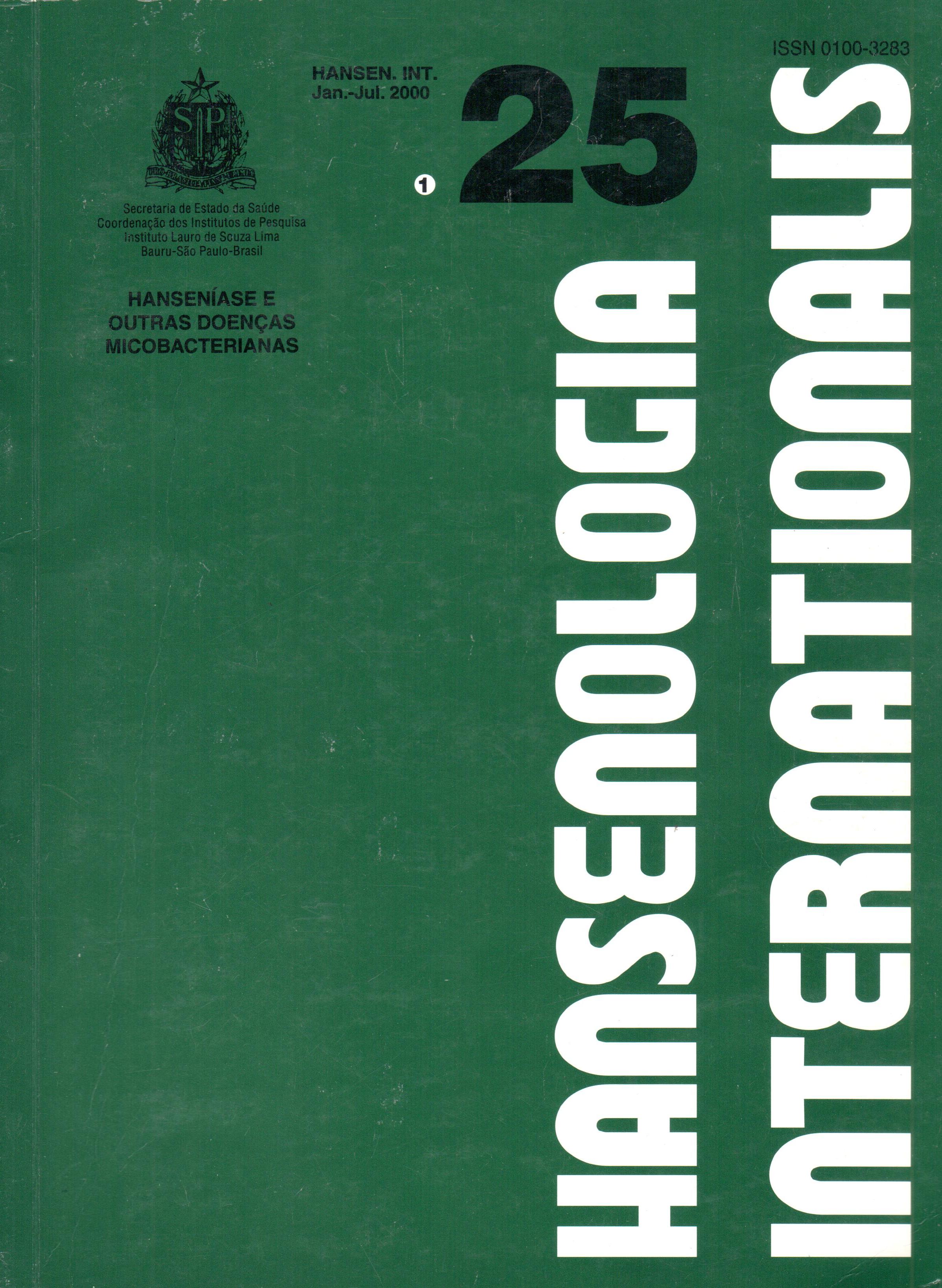Resumen
A hanseníase seria uma doença comum se não fosse por seus episódios reacionais com risco de incapacidades mantendo o estigma relacionado à "lepra". Essas reações e a perda potencial da função neural podem ocorrer antes, durante e após o tratamento, feito com poliquimioterapia (PQT). A alta por cura se dá pelo número de doses e regularidade do tratamento, quando o paciente sai do registro ativo e dos coeficientes de prevalência. Objetivando avaliar a magnitude das reações hansênicas pós-alta e as questões operacionais referentes a qualidade da assistência, foram revisados prontuários de 149 pacientes que
receberam alta de hanseníase de 1994 a 1999, no Centro de Saúde Escola Jaraguá — UFU, utilizando a Ficha de Investigação de Intercorrências Pós-Alta por Cura do Ministério da Saúde. Destes, 34 (23%) apresentaram reação pós-alta, sendo 11,76% PB e 88,23% MB. Ocorreu uma média de 3 episódios por paciente dimorfo e 4 por paciente virchowiano. Dos PB, 100% apresentaram reação reversa (RR). Entre os MB, 50% apresentaram RR, 40% eritema nodoso hansênico (ENH), 7% neurite isolada e 3% reação mista. Em 91% dos casos, o primeiro episódio reacional ocorreu no primeiro ano pós-tratamento. Houve correlação positiva entre IB médio no diagnóstico e número deepisódios reacionais durante o tratamento e pós-alta. Dos pacientes com reação pós-alta, 97% utilizaram prednisona e 32% talidomida, significando 22% e 8%, respectivamente,
dos pacientes em alta. Graus de incapacidade II e Ill ocorreram em MB da faixa etária economicamente ativa.
Discute-se a necessidade de implementar programas de controle específicos para esse novo grupo de pacientes, com garantia de medicamentos, capacitação de pessoal para o monitoramento simplificado das neurites e o manejo dos efeitos adversos da terapêutica com corticoesteróides, visando à prevenção de incapacidades.
Citas
2. BRASIL. MINISTÉRIO DA SAÚDE/ FMNS/ CENEPI/ CNDS. Campanha de divulgação de hanseníase: 1997 — 1999. 1997. 6p.
3. BRASIL. MINISTÉRIO DA SAÚDE / FUNDAÇÃO NACIONAL DA SAÚDE. Guia de controle da hanseníase. Ministério da Saúde — Brasil. 2á ed., Brasília, 1994. 156p.
4. BRASIL. MINISTÉRIO DA SAÚDE/ SPS/ DGSP/ CENEPI/ ENS. Hanseníase no Brasil, progressos e dificuldades em relação à eliminação. Ministério da Saúde - Brasil, 1998. 10p.
5. BRASIL. MINISTÉRIO DA SAÚDE/ SPS/ DGPE/ ATDS. Manual de Procedimentos para a Execução das Atividades de Controle da Hanseníase. Ministério da Saúde - Brasil, 1999. 83p.
6. CUNHA, M.G.S. Níveis de anti PGL — 1 no soro de pacientes com hansenfase tratados com quinolona e polioquimioterapia. Ribeirão Preto: USP, 1998. Tese (Mestrado em Clínica Médica) apresentada à Faculdade de Ribeirão Preto.
7. CUNHA, M.G.S., REBELLO, P.B., PENNINI, S.N., SADAHIRO, M., SCETTINI, P.M. Estados reacionais na hanseníase multibacilar pós tratamento polioquimioterápico. Hansen. Int., v. 22, n. 1, p. 115, 1997.
8. FERREIRA, M.L.C., VIEIRA, L.M.M., TEIXEIRA, O.M.J., MATOS, H.J., NERY,J.C.A., PEREIRA, R.M.O. Hanseníase: perfil sócio — econômico e uma população ambulatorial submetida à PQT. Hansen. Int., v. 22, n. 1, p. 103, 1997.
9. JACOBSON, R. R., KRAHENBUHL, J. L. Leprosy. The Lancet. v.353, p. 655-659, 1999.
10. LAFRATTA, T.E., BRASIL, M.L.R.E, MORZLIAK, M.L.C. Sistema de vigilância de incapacidades físicas pós alta por cura de casos de hanseníase. Hansen. Int., v. 22, n. 1, p. 66-67, 1997.
11. LOMBARDI, C., SUÁREZ, R.E.G. Epidemiologia da hanseníase. In: TALHARI, E.; NEVES, R.G. Hansenfase. 3ged., 1997,167p.
12. MARQUES, C.F.S., ALBUQUERQUE, E.C.A., FILHO, U.F.S., GALO, M. E. N. Baciloscopia em casos multibacilares pós 5 anos de alta do esquema PQT/ OM. Comparação entre os valores IB entre casos reacionais e não reacionais.Hansen. Int., v. 22, n. 1, p. 104, 1997.
13. MELLO, S., LOPES, A., AGUDELO, A.M.D.P., MORENO, CA., NERY, J.A.C. Corticoterapia nos estados reacionais da hanseníase — avaliação dos efeitos colaterais em um ambulatório da rede. Hansen. Int., v. 22, n. 1, p. 89-90, 1997.
14. MINAS GERAIS/ COORDENADORIA DE CONTROLE DE HANSENÍASE/ SECRETARIA DE ESTADO DA SAÚDE DE MINAS GERAIS/ DIRETORIA DE CONTROLE DE DOENÇAS TRANSMISSÍVEIS/ SUPERINTENDÊNCIA DE EPIDEMIOLOGIA. Encontro Estadual de Avaliação das Ações de Controle de Hanseníase. Belo Horizonte, 1999. 43p.
15. NAAFS, B. Leprosy reactions: new knowledge. Trop. Geogr. Med., v. 46, n. 2, p. 80-84, 1994.
16. NOORDEN, S.K. The epidemiology of leprosy. In: HASTINGS, R.C. Leprosy. New York: Churchil Livingstone Inc., p. 15-30, 1985.
17. OPROMOLLA, D.V.A. A Hanseníase Após a Cura. Hansen. Int., v.23, n. 1/ 2, p. 1-2, 1998.
18. ORGANIZAÇÃO PANAMERICANA DE SAÚDE/ OMS. Boletim - Eliminação da Hansenfase das Américas., n.6, 1998. 4p.
19. PEDRAllANI, E. S., HELENE, L.M.E, VIEIRA, C.S.C.A., VIETH, H., BEZERRA, C. M., MENDES, E. B. Capacitação de multiplicadores na área de enfermagem em hanseníase. Hansen. Int., v. 23, n. 1/2 p. 27-31, 1998.
20. PFALTZGRAFF, R. E., BRYCESON, A. Clinical leprosy. In: HASTINGS, R.C. Leprosy. New York: Churchil Livingstone Inc., p. 134-176, 1985.
21. SCHREUDER, P.A.M. Occurence of reactions and impairments in leprosy: experience in the leprosy control program of three provinces in northeastern Thailand. int. J. Leprosy., v. 66, n. 2, p. 159-169, 1998.
22. VIRMOND, M. Papel das instituições de pesquisa e ensino em hanseníase no controle de prevenção de incapacidades e reabilitação. Hansen.lnt., v. 24, n.1, p. 32-37, 1999.
23. WHO. Eliminacion de la Lepra. Preguntas y respustas. 1996. 17p. (WHO/LEP/96.6)
24. WHO. Um guia para eliminar a hanseníase como problema de saúde pública. Genebra, 1~ ed., Tradução em português, 1995. 61 p. (WHO/LEP/95.1)

Esta obra está bajo una licencia internacional Creative Commons Atribución 4.0.
